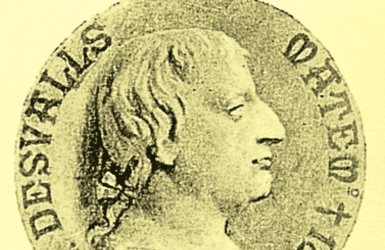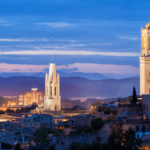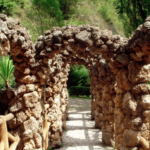
Visiting El Parc del Laberint d’Horta
THE BARCELONA MAZE PARK
Did you know there’s a maze in Barcelona? And no, I’m not talking about the alleys of the Gothic Quarter (although one can get disoriented there, true!). And I’m not talking about one of those escape rooms either. I mean a real cypress tree labyrinth Harry Potter’s Goblet of Fire style… minus the magic, of course. You will find it in the Horta District, off the beaten path and away from the tourist crowds, inside a public garden that used to be a private real state owned by nobles.
The place is a great thing to do with kids (you can even bring a picnic – there’s tables outside next to a playground). And it’s also a very romantic Barcelona location to propose. And it’s been featured in several movies such as Perfume: The Story of a Murderer.
Brief history of the Barcelona Labyrinth Park
1
Origins of the Parc del Laberint

In 1791 there was an aristocrat, Marquis of Llupia Joan Antoni Desvalls, who purchased a state in the village of Gracia, then a small town in the outskirts of Barcelona - but now one of the districts of the city. He was that kind of Renaissance guy that studied sciences and languages, was a philosopher but also fought against Napoleon and served as a member of the Parliament. And he decided to hire an Italian architect and a French gardener to design a Neoclassic garden in his state, that already included a cypress tree maze.
Half a decade later, his grandson Joaquim Desvalls hired the Catalan architect Elies Rogent to continue transforming the state. They created a romantic garden with a waterfall and a canal. And thirty years later his son added a domestic garden with a topiary collection and elements now lost such as a green house and beds of camellias. The Park was visited by Spanish Royals a few times, and it is said that King Charles IV loved it so much he hinted to Desvalls that he’d want to be gifted it by saying that “it was too much for a man”. But Desvalls was quick to reply that “indeed, but it wasn’t enough for a king”.
2
How the Horta Labyrith became a public park
In 1968 the Desvall family, not as wealthy has their ancestors had been anymore, couldn’t continue to maintain the garden and they negotiated its sale with the Barcelona City Council. The Labyrinth of Horta started then being restored, and it was open to the public in 1971 despite the restoration works still being in progress. Unfortunately, the amount of visitors (and lack of civility of some of them) led to a fast degradation of the gardens, and in 1994 the park had to undergo a second restoration campaign.
Eventually, it was decided to limit the number of visitors per day to only 750, and to make visitors pay a small fee to get in – which goes to the maintenance of the infrastructure. The neighbors, though, have free access, and seniors and kids under 5yo don’t pay either. And Sunday and Wednesday it’s free of charge – but it’s also more crowded….
What to see at the Labyrinth of Horta
3
Entering the park
4
The domestic garden
You will reach a semi-circular space flanked with 8 columns topped with pots decorated with lion heads. It’s called the Square of the Lions. Here an iron fence leads to the topiary garden in the back of the manor. This is the area of the domestic garden that has been best preserved – but unfortunately most of the time it’s not open to the public…
From the Square of the Lions, the exit opposite to the path you came from takes you to a quieter garden area that was also part of the domestic garden. The next path to the left takes you to an old washing sink: you may want to go that way to check it out, but then reverse towards the central path, which is the staircase that leads you to the labyrinth.
5
The maze garden
It’s not really difficult to find your way out of the maze, but it’s good fun to go there with friends and split. And you can find maps of it only and aerial pictures to help you prepare and beat your friends. But memorizing can be tricky, and… there’s an easier way to cheat: do as if you were going in with your friends, but when you can go back out unnoticed, then walk around the outside of the maze from the left of the entrance (your right, if you are leaving the maze) until you find the exit on the next corner. Then go inside and in two minutes the path will take you to the gazebo where you can wait for your friends and make them think you beat them! LOL!
6
Staircase and terrace
The terrace overlooks the labyrinth, and here were celebrated all kind of social events, from outdoors theater plays to receptions with the Spanish Royals. The terrace is flanked by two pergolas, each with its own sculpture. One of them is Danae and the other is Ariadne – both characters of the classical mythology who were abandoned by their lovers. Following the garden theme, they represent disillusion.
7
The upper level of the park
Now climb the stairs that head to the right of the pavilion and you’ll reach a water reservoir that was created in 1791 to collect water for the gardens – so it’s there for functional reasons, not just for its beauty. And it’s also quite deep. Walk around it, and in the other end you’ll find the Fountain of Egeria, a Roman nymph that was transformed into a fountain after crying herself away when her husband died. Here ends the allegory of Love that mr. Desvalls designed.
8
The Romantic Garden
BTW, when we say “romantic garden” it doesn’t go with the modern concept of romanticism (cupids and hearts, and all that jazz). In the old times romantic meant decadent, wild-nature looking even if manmade, a bit dark but not horror-movie scary. Think a place where Lord Byron and Mary Shelley would feel at ease. So you’ll first go by an artificial waterfall made with rocks and covered with moss. The water is then channeled through irrigation canals that run down the valley, along flower beds and old trees.
This is a more shadowy and quieter area of the park, where you’ll find benches to seat and relax listening to the sounds of the water flowing, and elements of the past like the remains of the Ermit Hut (where Desvalls kept a rudimentary automaton robot that looked like a meditating monk), a circle of cypress trees that emulated a cemetery, and the House of the Farmer (another automaton that looked like a farmer holding a handful of keys – not there anymore either, unfortunately). Eventually you’ll find the way out through the Asian looking gate that you saw when you entered the park.
How to get to the Labyrinth park of Horta
9
Location and Transportation
- Address: Passeig dels Castanyers, 1. 08035, Barcelona (Spain)
- Official website of the Horta maze
- Closest subway station: Mundet (L3, green line). Make sure to leave the station through the Arturo Mundet exit (the one with the elevator), as the other one will take you to the other side of the Ronda de Dalt road ring which is the wrong side of the road. From Arturo Mundet there’s signs you can follow to the park. It’s a 7 minute walk, past the Velodrome.
- Closest bus lines: 27, 60, 76 and H4. Unfortunately none of them connects with the city center. But you can use the 27 bus to get you to Sants Station and sort of close to Park Guell, and bus H4 leaves you sort of close to the Cosmocaixa science museum. Sorry, the hop-on hop-off buses don’t get you any close to the Parc del Laberint…
10
Opening hours and tickets
- Opening time: 10AM, daily
- Closing time: 6PM (November through March), 8PM (April through October). Christmas day at 2PM.
- Horta Labyrinth tickets: Only available for sale at the park ticket office (no online sale).
- Open doors: Every Sunday and Wednesday the access is free.
Things to do near the Parc del Laberint d'Horta
11
Exploring
- For more beautiful gardens, head to the nearby Palau de les Heures.
- For street art and graffiti, check out the Plaça Botticelli.
- For contemporary art, see the sculpture of the giant matches “Els Mistos” by Claes Oldenburg.
- To see the “real Barcelona”, explore the Horta neighborhood.
12
Eating
- Can Cortada and Can Travi Nou, two old Catalan masia farmhouses turned into restaurants serving traditional Catalan cuisine.
- Can Ginesta, a neighborhood restaurant frequented by locals serving Spanish food such as paella, fideua and tapas.
- Summum, the restaurant of a well known Tourism School in the area, run by its students.
- There’s also a small kiosk by the entrance of the Park of the Labyrinth next to the playground and the picnic area, selling chips, ice cream, sodas and snacks.
Are you planning to visit the Parque del Laberinto de Horta?
Marta
RESEARCHING FOR A TRIP IS TIME-CONSUMING…
Need more inspiration?
Our 100% FREE Barcelona Collection will give you everything you need to organize the trip of your lifetime to Barcelona.
BEST INSIDER TIPS FROM THE PROS!








